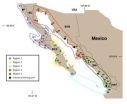(Press-News.org) For the first time, scientists have mapped the genome--the genetic code--of orangutans. This new tool may be used to support efforts to maintain the genetic diversity of captive and wild orangutans. The new map of the orangutan genome may also be used to help improve our understanding of the evolution of primates, including humans.
Partially funded by the National Science Foundation, the orangutan study appears in the Jan. 27 issue of Nature. It was conducted by an international team of scientists led by Devin P. Locke of the Genome Center at Washington University.
Conservation implications
The name "orangutan" is derived from the Malay term, "man of the forest," a fitting moniker for one of our closest relatives.
There are two species of orangutans, defined primarily by their island of origin--either Sumatra or Borneo. The outlook for orangutan survival is currently dire because there are estimated to be only about 7,500 orangutans in Sumatra, where they are considered critically endangered, and only about 50,000 orangutans in Borneo, where they are considered endangered.
The endangerment status of orangutans is determined by the International Union for Conservation of Nature.
There are no other wild populations of orangutans other than those in Sumatra and Borneo. The decline of the Sumatran and Borneo populations of orangutans is caused by varied threats, such as illegal logging, the conversion of rain forests to farmland and palm oil plantations, hunting and diseases.
Using a mix of legacy and novel technologies, the research team mapped the genomes of a total of 11 orangutans, including representatives of both the Sumatran and Bornean species.
The map of the orangutan genome may support conservation efforts by helping zoos create breeding programs designed to maintain the genetic diversity of captive populations. (The greater the genetic diversity of a species, the more resilient it is against threats to its survival.) The genome map may also help conservationists sample the genetic diversity of wild populations so they can prioritize populations of wild orangutans for conservation efforts.
Evolutionary implications
After scientists map a species' genome, they compare it to the genetic maps of other species. As they do so, they search for key differences that involve duplications, deletions and inversions of genetic material. These differences may contribute to the unique features of particular species. They may also provide information about general evolutionary trends, such as the overall rate at which genomic evolution has occurred.
Before the orangutan's genome was mapped, the genetic codes of three other great primates--humans, chimpanzees and rhesus macaques--were mapped.
The genomes of the gorilla and bonobo will soon be mapped, as well.
Analyses of the orangutan genome reveal that this primate has many unique features. For example, comparisons of the structural variation of the genomes of orangutans, humans, chimpanzees and rhesus macaques indicate that during the last 15 million years or so of primate evolution, the orangutan genome has generally been more stable than those of the other primates, with fewer large-scale structural changes.
The orangutan genome also allowed for an analysis of fast-evolving genes, which are likely to have responded to evolutionary pressure for adaptation. Genes related to visual perception and metabolic processes were found to evolve unusually rapidly in orangutans and other primates. The orangutan's metabolism-related genes were also found to have evolved rapidly--a phenomenon that may be related to the organgutan's slow growth rate, slow reproduction rate, and long inter-birth interval, the period between successive births. Organutans give birth not more than once every six to eight years, an inter-birth interval rated as the longest among mammals, including humans.
Comparisons of the population genetics of the Sumatran and Bornean species indicate that these species split approximately 400,000 years ago, which is more recent than previously believed. In addition, Sumatran orangutans have greater genetic diversity than their Bornean counterparts, despite their smaller population size and higher endangered status.
Adam Siepel, a research team member from Cornell University described the new map of the genetic code of orangutans as an important step in genome sequencing of primates. "The orangutan genome gives us a much more complete picture of genome evolution in the great apes," he said.
"This is a terrific example of the application of genome sequencing beyond model organisms--well-studied organism like the mouse and fruit fly," said Reed Beaman, an NSF program director. "Research like this has only recently become possible through a dramatic decrease in the cost of sequencing. These results demonstrate broad significance to biogeography, genetics, as well as to conservation and human evolution, and they are only starting to scratch the surface."
INFORMATION: END
We have developed an 'anytime' intelligence test, in other words a test that can be interrupted at any time, but that gives a more accurate idea of the intelligence of the test subject if there is a longer time available in which to carry it out", José Hernández-Orallo, a researcher at the Polytechnic University of Valencia (UPV), tells SINC.
This is just one of the many determining factors of the universal intelligence test. "The others are that it can be applied to any subject – whether biological or not – at any point in its development (child or adult, for example), ...
Madison, WI January 27, 2011 – Soybean production has continued to increase in the Northeast United States with more and more first time growers planting the crop and many experienced growers planting alongside corn crops. To save on time and expenses, some farmers plant soybeans with a corn planter in 30-inch rows instead of 7.5-inch rows with the regularly used grain drill.
Dr. William Cox, a Cornell University scientist, investigated the response of two soybean varieties in row widths of 7.5, 15, and 30 inches at four seeding rates in a study funded by a USDA Hatch ...
The first large-scale, physics-based space weather prediction model is transitioning from research into operation.
Scientists affiliated with the National Science Foundation (NSF) Center for Integrated Space Weather Modeling (CISM) and the National Weather Service reported the news today at the annual American Meteorological Society (AMS) meeting in Seattle, Wash.
The model will provide forecasters with a one-to-four day advance warning of high speed streams of solar plasma and Earth-directed coronal mass ejections (CMEs).
These streams from the Sun may severely disrupt ...
A team of scientists at Johns Hopkins and elsewhere has discovered that a single alteration in the genetic code of about a fourth of African-Americans helps protect them from coronary artery disease, the leading cause of death in Americans of all races.
Researchers found that a single DNA variation - having at least one so-called guanine nucleotide in a base pair instead of a combination without any guanine - on a gene already linked to higher risk of coronary disease in other races is linked in blacks to decreased risk. Specifically, the study showed that otherwise ...
DETROIT – Patients with obstructive sleep apnea who undergo surgery to improve their breathing get a better night's sleep and therefore are less drowsy during the day, according to a new study from Henry Ford Hospital in Detroit.
The study finds surgery greatly reduces daytime sleepiness – a common side effect from this disorder in which the upper airway is partially or completely blocked during sleep – when compared to other non-surgical treatments for obstructive sleep apnea.
"This study validates what patients have told us regarding their improved alertness after ...
Scientists have created a diamond-like lattice composed of gold nanoparticles and viral particles, woven together and held in place by strands of DNA. The structure – a distinctive mix of hard, metallic nanoparticles and organic viral pieces known as capsids, linked by the very stuff of life, DNA – marks a remarkable step in scientists' ability to combine an assortment of materials to create infinitesimal devices.
The research, done by scientists at the University of Rochester Medical Center, Scripps Research Institute, and Massachusetts Institute of Technology, was published ...
CHAMPAIGN, Ill. — When it comes to breaking down plant matter and converting it to energy, the cow has it all figured out. Its digestive system allows it to eat more than 150 pounds of plant matter every day. Now researchers report that they have found dozens of previously unknown microbial enzymes in the bovine rumen – the cow's primary grass-digestion chamber – that contribute to the breakdown of switchgrass, a renewable biofuel energy source.
The study, in the journal Science, tackles a major barrier to the development of more affordable and environmentally sustainable ...
Researchers at Scripps Institution of Oceanography at UC San Diego have completed a new study on the geography of commercial fisheries in Northwest Mexico and the results could have far-ranging implications for the sustainable future of marine wildlife in the area.
The scientists, led by Scripps postdoctoral researcher Brad Erisman, analyzed data from local fisheries offices around the region that includes Baja California as well as Gulf of California coasts from Sonora south to Nayarit. The region accounts for more than 60 percent of fishing production in Mexico.
The ...
University of Alberta researchers determined that a fossilized dinosaur bone found in New Mexico confounds the long established paradigm that the age of dinosaurs ended between 65.5 and 66 million years ago.
The U of A team, led by Larry Heaman from the Department of Earth and Atmospheric Sciences, determined the femur bone of a hadrosaur as being only 64.8 million years old. That means this particular plant eater was alive about 700,000 years after the mass extinction event many paleontologists believe wiped all non-avian dinosaurs off the face of earth, forever.
Heaman ...
Researchers at Cincinnati Children's Hospital Medical Center have identified biomarkers of poor outcomes in preterm infants that may help identify new approaches to prevention.
Ardythe Morrow, PhD, a researcher at the Cincinnati Children's Perinatal Institute, has identified a polymorphism – a variant in a particular DNA sequence – in a gene important to the development of the immune system. She found that this polymorphism raises the risk of bad outcomes in preterm infants, including death; necrotizing enterocolitis, which is the death of intestinal tissue; and gram ...




